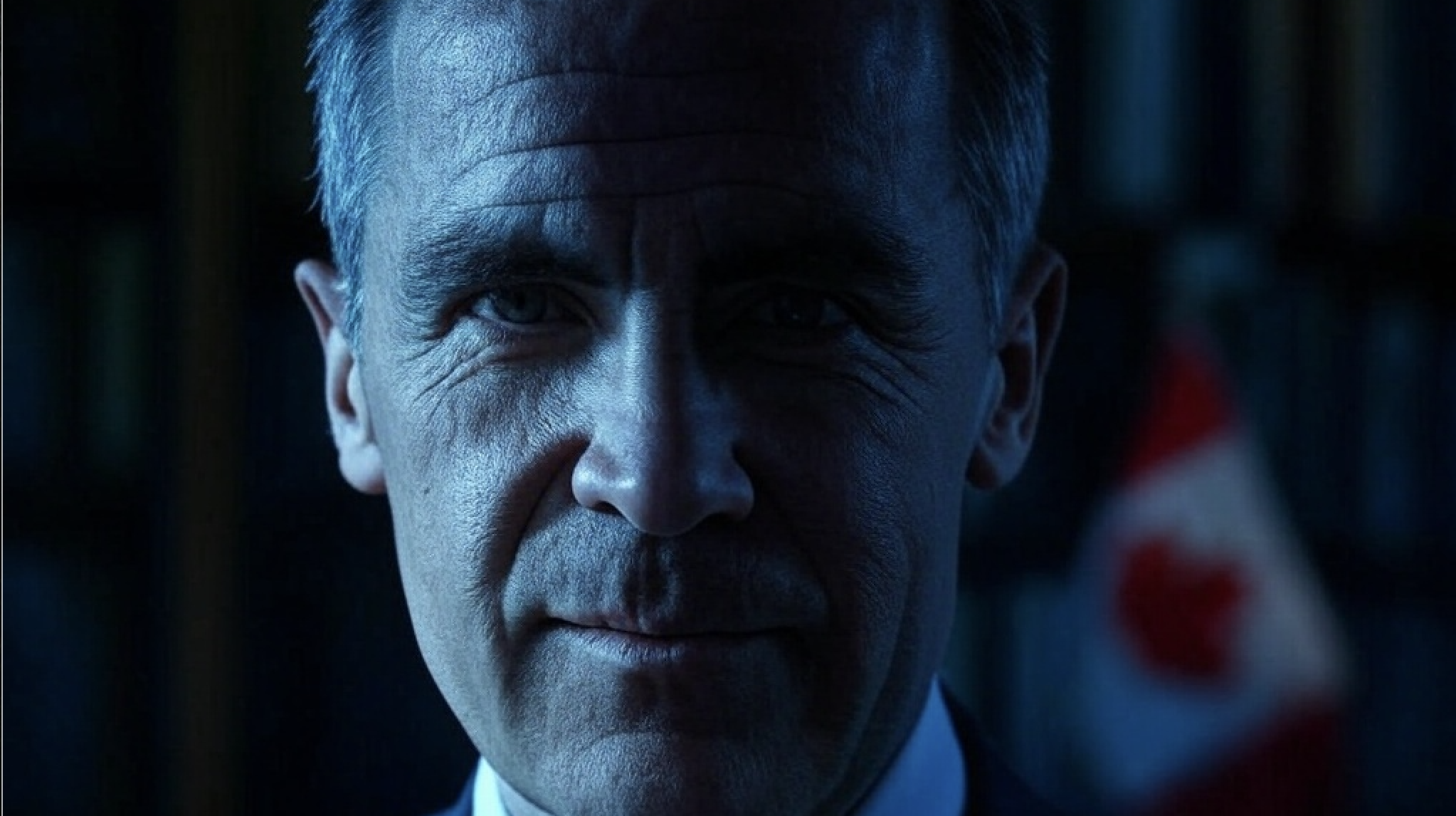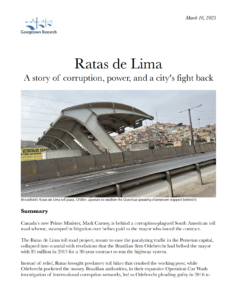
by J. Michael Waller
Canada’s new Prime Minister, Mark Carney, is behind a corruption-plagued South American toll road scheme, swamped in litigation over bribes paid to the mayor who issued the contract.
The Rutas de Lima toll road project, meant to ease the paralyzing traffic in the Peruvian capital, collapsed into scandal with revelations that the Brazilian firm Odebrecht had bribed the mayor with $3 million in 2013 for a 30-year contract to run the highway system.
Instead of relief, Rutas brought predatory toll hikes that crushed the working poor, while Odebrecht pocketed the money. Brazilian authorities, in their expansive Operation Car Wash investigation of international corruption networks, led to Odebrecht pleading guilty in 2016 to what the U.S. Department of Justice called “the largest foreign bribery case in history.”
Yet, the elaborate plea bargain arrangement with DOJ in New York oddly omitted any reference to Rutas de Lima. Just before the scandal broke wide open, Odebrecht offloaded most of its stake to Brookfield, a Toronto-based investment and asset management giant, for about $500 million. Brookfield knew South American public works business like few others. But it claimed its due diligence had found nothing wrong with its new Odebrecht asset.
New leadership emerged in 2022. On one side stood Brookfield chairman Mark Carney, a powerful ESG or Environment, Social, and Governance advocate – and now Canada’s prime minister – who sidestepped the mess while his company kept turning the screws on the city of Lima. On the other side emerged Lima’s freshly elected Mayor Rafael López Aliaga, a populist fighting to dismantle the corrupt contract.
Brookfield defended its soiled Rutas asset through costly United Nations arbitration, profiting from Rutas escaping itemization in the 2016 plea bargain. The tolls remain, doubts swirl about the DOJ prosecutors’ impartiality during the plea bargain – particularly Andrew Weissman, the ex-DOJ Fraud Section chief – that let Odebrecht pay at the lowest end of the sentencing guideline range and kept Rutas’ name out of the arrangement.
Brookfield then went on the offensive against Lima, portraying itself as the victim and suing the city for $2.7 billion in lost revenue. “Rutas” or “Routes” had become toxic in the eyes of many locals who now call the highway project “Ratas de Lima,” or Rats of Lima.
A Georgetown Research risk analysis report (Download report here)
Contents
- Panoramic overview

- The deal that started it all
- Operation Car Wash uncovers the bribery
- Who was bribing and who was being bribed
- Painful movement at the toll roads
- Odebrecht’s empire of concrete and ashes
- DOJ: ‘Largest foreign bribery case in history’
- Brookfield gets indemnified as it buys up Odebrecht’s corrupt contracts
- How Brookfield entered Rutas de Lima
- Two new leaders in 2022
- Mark Carney, credentialed sustainable cleanup man
- Rafael López Aliaga, self-made entrepreneur
- Brookfield takes its case to UN arbitration, Lima takes it to New York
- ‘Delivering value’ by jacking up the tolls
- Brookfield chairman becomes Canada’s unelected prime minister
- Brookfield hails three decades in Peru
- Appearances of impropriety
- Foley Hoag
- US Justice Department prosecutors and their law firms
- Conclusion and questions
- Exhibits
Exhibits appear in separate annex to this report
- Força-Tarefa Operação Lava Jato, Ministério Público Federal Procuradoria da República no Paraná, in Portuguese original; and Operation Car Wash Task Force, Federal Public Prosecutor’s Office, Attorney General’s Office in Paraná (Brazil), in English translation, “Brookfield Brazil Capital Partners LLC (‘Brookfield’).” (6 pages)
- Correspondence of Municipality of Lima Prosecutors regarding Foley Hoag, facsimiles of original documents in Spanish and English (10 pages)
- “Anexo D,” including “Sworn statement: Proposal for legal assistance services for the Republic of Peru, September 25, 2013,” original in Spanish (11 pages)
Panoramic overview
A city of ten million people, its arteries choked with diesel buses and countless cars, presents a contrast of modern glass towers and crowded concrete houses on a sprawlscape between the Andes and the Pacific. This is Lima, the thriving, congested capital of Peru.
In 2013, a promise glimmered relief through the smog: New toll roads to tame the chaos, overpasses to lift the gridlock, a modern lifeline for an energetic metropolis stalling from congestion. The deal came wrapped in the polished name of Rutas de Lima, a consortium led by Brazil’s multinational construction titan, Odebrecht. But beneath the surface of this grand bargain lay a festering scandal – a story of secret meetings, stuffed envelopes, and a crooked mayor’s desperate gamble to cling to power.
This is the Rutas de Lima toll road saga, a modern Peruvian tragedy where ambition clashed with betrayal. Super-wealthy foreign social justice warrior investors bought the corrupt contract and made war with the city.
Lima residents lose more than a billion hours a year stuck in the clogged, polluted streets. The collective time lost to road congestion in Lima each year is equal to more than 2,000 people living their entire lives, from birth to death, stuck in traffic.[1]
The deal that started it all
Nobody could solve the worsening problem. Lima Mayor Susana Villarán was desperate for anything. It was 2012, and the progressive politician faced political destruction from an upcoming referendum to demand her recall.
In front of her dangled a lifeline: the Rutas de Lima project. It had been in the development stages for six years. On September 18, Villarán handed a huge Brazilian construction colossus, Odebrecht, a golden ticket: A 30-year lease to run Rutas de Lima. It was a big deal: About 71 miles or 115 kilometers of three toll roads snaking across the city through its expanding outskirts to the north, south, and west.[2] Rutas de Lima would collect tolls from a quarter million vehicles a day.
At the rate when the tolls would go into effect, that was roughly $418,000 a workday, or just over $104,000,000 million a year, not counting weekend and holiday traffic. In constant dollars, that was more than $3.13 billion in tolls over 30 years.[3]
That was just the start. In exchange for building overpasses and maintaining the system, Rutas could impose tolls on drivers and ratchet up the price as it wished. Villarán’s terms for Odebrecht were suspiciously sweet – guaranteed daily cash flow, random rate hikes, little oversight, and contracts designed to be amended to keep the concession going – like a gift too good to question. But questions came soon enough, as loud whispers of corruption spread like diesel smoke through the talkative city.
Mayor Villarán’s arrangement in advance of the recall referendum was one of those coincidences too convenient to ignore. Defeating that vote would cement her control – and the Rutas deal. Odebrecht had a successful working formula across Latin America: when in doubt, pay to play.
The pay came quickly, with $3 million funneled to Villarán’s anti-recall campaign.
Villarán’s campaign manager, José Miguel Castro, was the alleged middleman, a shadowy figure greasing the wheels with Brazilian cash. Another Brazilian firm chipped in another million dollars, though the details blur in the haze of accusations.
By January 2013, with the contract locked in, Villarán defeated the referendum and clung to her seat. Arbitrators and an American federal court would later say that insufficient evidence existed to prove that bribes directly swung the award. Such arrangements were common custom in Peru. Almost a decade later, Lima would elect a new mayor to bulldoze the city’s smothering corruption.
Download the full report here.
Download the report with exhibits here.
